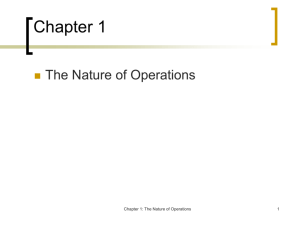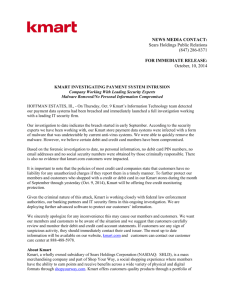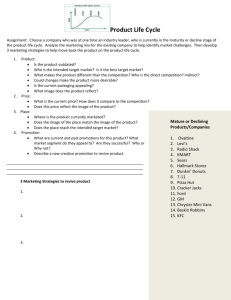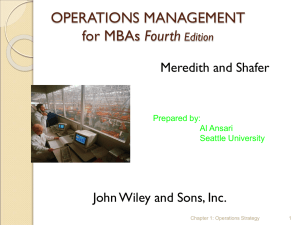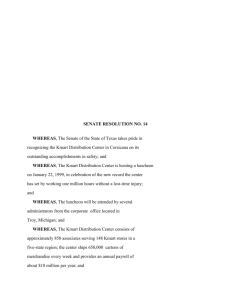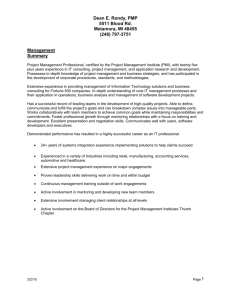module_3 - Homework Market
advertisement
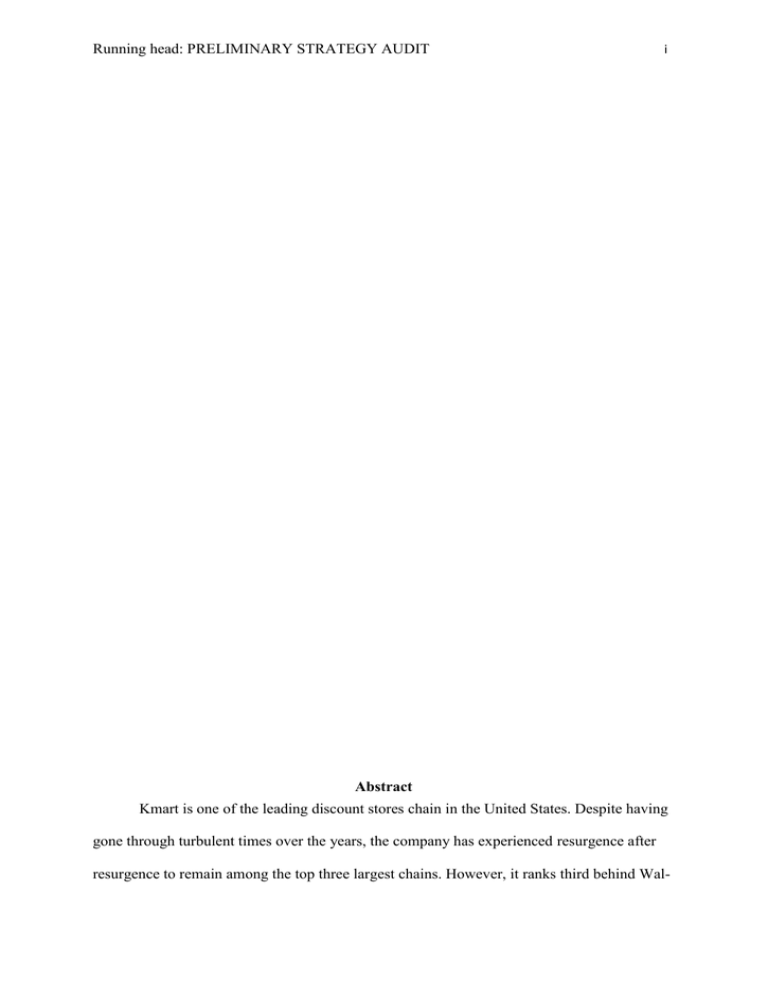
Running head: PRELIMINARY STRATEGY AUDIT i Abstract Kmart is one of the leading discount stores chain in the United States. Despite having gone through turbulent times over the years, the company has experienced resurgence after resurgence to remain among the top three largest chains. However, it ranks third behind Wal- PRELIMINARY STRATEGY AUDIT ii Mart and Target, despite being a pioneer of the discount stores ‘movement’. This paper took a closer look at Kmart’s value proposition, market position and competitive advantage. it also scanned its current environment and that of the industry by applying the Porter’s five forces model. Identified several strategic issues that Kmart must re-look so that it can either regain its leadership position in the industry or remain as a worthy player in the industry. For instance, it should tailor its target market from the urban areas where its stores are predominantly located. It should also abandon the cost leadership approach in its pricing strategy. Adapting technology in managing its inventory and merchandising would go a long way in cutting its costs. Revitalising its brand image should focus on creating a unique customer experience. Furthermore, besides transforming its methods the company should look at management changes to steer it from repeating similar mistakes that has led it to the current situation. PRELIMINARY STRATEGY AUDIT iii Table of Contents ABSTRACT .............................................................................................................................. I TABLE OF CONTENTS ..................................................................................................... III 1 INTRODUCTION ............................................................................................................ 1 1.1 1.2 1.3 2 VALUE PROPOSITION .................................................................................................... 1 MARKET POSITION ....................................................................................................... 2 COMPETITIVE ADVANTAGE .......................................................................................... 2 EXTERNAL ENVIRONMENTAL SCAN/FIVE FORCES ANALYSIS.................... 3 2.1 CURRENT ENVIRONMENT ............................................................................................. 3 2.2 FIVE FORCES ANALYSIS ............................................................................................... 3 2.2.1 Buyer Power ............................................................................................................ 3 2.2.2 Supplier Power ........................................................................................................ 3 2.2.3 Rivalry ..................................................................................................................... 4 2.2.4 New Entrants ........................................................................................................... 4 2.2.5 Substitutes ................................................................................................................ 5 3 STRATEGIC ISSUES ...................................................................................................... 5 3.1 3.2 3.3 3.4 3.5 4 TARGET MARKET ......................................................................................................... 5 PRICING ........................................................................................................................ 6 INVENTORY MANAGEMENT .......................................................................................... 6 BRAND IMAGE .............................................................................................................. 7 MANAGEMENT ............................................................................................................. 7 SUMMARY/ KEY FINDINGS AND RECOMMENDATIONS .................................. 7 REFERENCES: ....................................................................................................................... 9 Running head: PRELIMINARY STRATEGY AUDIT 1 1 Introduction Kmart’s story began when Sebastian Kresge opened a store in Detroit back in 1899. His low prices appealed to many customers and he was able to open an additional 84 stores in the next thirteen years. Currently, the Kmart business empire has about 1500 stores and operates an online store, Bluelight.com. The brand stands for quality products and low prices. Despite many challenges presented by wars and financial crises, the business did not fizzle out. It continued its expansion and opened ‘discount stores’ that sold goods for a dollar or less (searholdings.com). The discount stores chain has beat all odds to become the world’s third largest chain behind Target and Wal-Mart. 1.1 Value proposition Kmart is a subsidiary of the Sears Holding Corporation that offers its customers quality products at affordable prices. The discount stores chain offers an assortment of merchandise that includes consumer electronics, toys, garden equipment, outdoor living, food products, apparels and seasonal products. A few years back, it acquired Sears and thus offers some Sears brand merchandise such as Kenmore and Craftsman. Some Kmart stores operate Sears Auto Centres that offer professional motor repair, maintenance and a wide array of motor accessories. Kmart carries several exclusive brands such as Smart Sense, Route 66, Joe Boxer and Jadyn Smith. A majority of Kmart stores run in-store pharmacies. About 25 Kmart Super Centres operate 24-hours-a-day and carry groceries and merchandise similar to that offered in the discount stores. Kmart is part of the ‘Shop Your Way’ social experience where registered members earn points which they can redeem them while shopping. Kmart runs the layaway program that lets customers finance their online and in-store purchases in a cost-effective manner. Customers can also purchase merchandise online and then pick up at their desired store through a service offered by MyGofer. Kmart customers can also purchase products through kmart.com as well as by using a mobile application (searsmedia.com) PRELIMINARY STRATEGY AUDIT 1.2 2 Market Position Kmart currently ranks as the third largest chain in the discount stores industry, behind Wal-Mart and Target. Over the past few years, the chain has stumbled due to intense competition, its dwindling grocery business and an increased onslaught in the urban areas. This has seen its sales volume decline. Although, Kmart introduced the layaway program, other competitors have pushed this idea further and thus introduced more competition for low-income earners (Mattioli, 2013). Kmart has had its fair share of challenges. For instance, the company had to file for bankruptcy in the early 2000s. Furthermore, the retail chain has had to close non-performing stores over the years. When Edward Lampert came in as CEO, the chain received a breath of fresh air that included the Sears-Kmart merger. However, several missteps have slowed down the anticipated full recovery (Schultz, 2012). 1.3 Competitive Advantage Competitive advantage refers to the ability of an organization to generate more sales and profits, and sustain more customers that its competitors. Kmart offers a quasi-banking service at its stores for low-income customers who do not operate bank accounts. This allows individuals to use their social security checks shop at the stores. The stores also offer checkcashing services at over six-hundred stores in its network. It has also collaborated with different utility companies to enable their customers to pay for water, gas and cell phone bills at the stores. These services are expected to retain existing customers and lure new ones. Although, Kmart introduced the layaway program, intense competition has forced it to respond with a free layaway program (Mattioli, 2013). According to Schultz (2012), Kmart has many stores located closer to urban residential areas than any other competitor. This provides it with an opportunity to become a PRELIMINARY STRATEGY AUDIT 3 niche player. After the Sears-Kmart merger, the discount stores could carry Sears branded items which increases its customer traffic. 2 2.1 External Environmental Scan/Five Forces Analysis Current environment The discount stores industry has grown into an extremely competitive one. This has led its pioneer Kmart to falter and even seek bankruptcy reorganization. The different players in this industry compete on price. However, the emergence of new entrants has led to the evolution of differentiating factors as the clamour for market share intensifies. For instance, Wal-Mart focused on rural America and the suburbs and became a force to reckon with in its use of technology to manage its inventory. Conversely, Target adopted a hybrid of lowpricing and high quality experience with its product offerings and its stores. 2.2 Five Forces Analysis The Porter’s five forces analysis model assists an organization to learn where power is in the business. It forms the basis for analysis of the attractiveness of the structure of an industry. Therefore a business can assess its current strength of its competitive position and the strength of the desired position (notedesk.com). 2.2.1 Buyer Power Ordinarily, when individual buyers, who are negligible regarding a firm’s total sales, give threats to switch, then such threats are not overwhelming to the organization (Mcafee, 2012). Over the years, Kmart has faced bad publicity due to investigations on their top executives and its wanting performance. The closure of non-performing stores has also reduced the traffic in the remaining stores. This is because a majority of Kmart customers believe that the stores chain is leaving the business. 2.2.2 Supplier Power PRELIMINARY STRATEGY AUDIT 4 Kmart relies on its suppliers to deliver products. The company has a nationwide network of stores even in prime shopping areas; hence its suppliers are many. The supplier power in the retail industry is fair. Even though Kmart has undergone many challenges that include bankruptcy it still yields enough power over the suppliers. This is because not many suppliers or Kmart are willing to end the relationships. Kmart purchases in huge volumes and has huge shelf space, therefore the suppliers will not just abandon it. For instance, Kmart has the power to allocate a competing brand larger shelf spaces if a supplier increases their prices. 2.2.3 Rivalry There is intense competition in the discount stores industry. This is due to the presence of many rivals offering the same products and services. Furthermore, there also exists fierce price competition (as implied by the term ‘discount stores’). There industry is dominated by three main rivals i.e. Kmart, Target and Wal-Mart, which makes it almost an oligopoly. The rivals have tried to differentiate themselves using different approaches. For instance, Wal-Mart portrays itself as a low-price leader and Target puts across its value proposition. Kmart has not really been successful in portraying a steady image. This is because its carries branded merchandise that fits into its value proposition strategy, as well as trying to compete on pricing although Wal-Mart remains on top (Hopkins, 2003). Kmart has not been able to match Wal-Mart’s technological prowess. On the other hand, Target’s phenomenal growth, partly because of Kmart’s woes, is another troublesome issue for Kmart. Kmart lost many customers to other stores such as Target and Wal-Mart during the bankruptcy period and also when it decided to close some of its stores. These customers may view the switching costs back to Kmart as too high, and thus the retail chain will have to provide them with convincing differentiators to lure them back. 2.2.4 New Entrants PRELIMINARY STRATEGY AUDIT 5 The discount stores industry presents high entry barriers to new entrants. In order to compete effectively with chains like Target and Wal-Mart would first have to be in a position to compete on cost. Apart from the large capital outlay a new entrant would require, they would also face difficulties in getting reliable distribution chains and suppliers. Therefore, the threat from new entrants is minimal. However, Kmart is the third largest stores chain in the United States. Wal-Mart boasts of superior inventory as well as distribution capacities, lowcost labour and real estate structure, and an advanced satellite-based communications network. 2.2.5 Substitutes The substitutes to the discount stores may be grocery stores, club stores, brand-name stores, dollar stores and other small discount retailers. However, the big discount stores offer a wide range of merchandise; hence they actually have few true substitutes. On the other hand, many people would rather look for an item from a huge store that carries many items rather than in a brand-name store. Kmart also has the advantage of having an online store. Therefore, all these other alternatives present very low threat. 3 3.1 Strategic issues Target Market Kmart has struggled to define its target market guided by customer expectations. The Sears merger, inclusion of branded house ware, apparel lines amongst other things has helped Kmart to keep operating. However, to survive in the long run Kmart should expressly define itself, the target market and see through the implementation of its strategy. Once it has clearly differentiated itself, Kmart should change its focus to design branded merchandise rather than commodity-type products. It should also increase its marketing campaign to clarify its brand position. Schultz (2012) notes that Target and Wal-Mart used about three times in media PRELIMINARY STRATEGY AUDIT 6 marketing each, than what Kmart spent in 2010 and 2011. Both competitors focused their campaigns on low pricing. 3.2 Pricing The discount stores industry is guided by price. Unfortunately, Kmart has limited options on how to effectively counter Wal-Mart’s and Target’s low-price models. A majority of Kmart’s customers are price-sensitive, and therefore it cannot segment the customers by offering them different prices on the basis of different characteristics. Therefore, Kmart is left with limited options for their price discrimination strategy. For instance, it could adopt coupons for price-sensitive clients and bulk discounts for customers willing to buy items in large quantities. However, none of these strategies would be special to Kmart, as it would lead to enhanced competition. In fact, Wal-Mart with its wide-ranging efficient management and vertical integration would have a better advantage. Thus, Kmart should abandon the cost leadership strategy in the short run until it has adequate infrastructure, as it would only eat into its resources. 3.3 Inventory Management Kmart has not done well in inventory management and merchandising. Some of the merchandising problems that Kmart has faced include weak supply-chain management, recurrent stock outs, unnecessary inventory of slow-moving merchandise and shaky pricing strategies. Currently, Kmart needs to look into ways it can improve its financial position without necessarily opening new stores. Therefore it should invest in technology that guarantees merchandising optimization. This will enable Kmart to come up with solutions that make it easier to make decisions on pricing decisions and profitable buying on the basis of consumer demand. Some of the options that Kmart would consider are Retail Revenue Management, Demand-Based Management and Pricing & Revenue Optimization. Kmart will PRELIMINARY STRATEGY AUDIT 7 then be able to apply advanced data processing techniques on its inventory data and accurately forecast supply and demand patterns on individual items and the entire store. 3.4 Brand Image The tough times that Kmart has gone through have dented the image of one of the most recognizable United States retail brand. This has been occasioned by the closure of some stores and the bankruptcy. The poor merchandising and unappealing stores have not helped the situation. That is why Kmart must purposely reinvent and re-design the customer experience. They must make it about buying the Kmart idea, the Kmart ethos, and the Kmart lifestyle rather than just buying products from Kmart. However, a transformation of the brand will require culture changes within Kmart management. They have to focus on the long term performance and not just close down poorly performing stores. 3.5 Management A close look at Kmart’s top executives will reveal that the company is exceptionally insulated i.e. not many outsiders have come on board to steer the company out of the murky waters. This is perhaps the reason why there have repeated mistakes processes, and the boardroom has been experiencing internal wars and fiefdoms. Instead of focusing on the reorganization of processes and procedures, the company should consider management restructuring for Kmart to re-affirm its relevance in the industry. 4 Summary/ Key Findings and Recommendations Kmart must expressly define itself and the target customers. Kmart’s presence in the urban areas gives it an advantage over its competitors who do not have many stores, and therefore it should develop its product lines to suit the urban residents. Kmart must reposition its brand through advertising to the target groups. It must revamp its inventory management and merchandising and probably acquire technology that will make these processes easier. It must hire top-notch senior managers, especially in marketing and PRELIMINARY STRATEGY AUDIT 8 merchandising, from outside the company to assist it to get over its perennial problems. These measures will require the management to make some tough decisions if consumers are going to have the ‘bluelight special’ experience in future. 9 PRELIMINARY STRATEGY AUDIT References: About Kmart (n.d.), Retrieved 13th Sept 2013 from http://searsmedia.com/kmart/kmart.htm Corporate History: A retailing legend is born (n.d.), Retrieved 13th Sept 2013 from http://www.searsholdings.com/about/kmart/history.htm Hopkins, J. (2003), Wal-Mart’s influence grows: Retailer’s power touches everything from price to wages. Money Mattioli, D. (2013), Déjà vu for Sears CEO: Fix Kmart. Retrieved 13th Sept 2013 from http://online.wsj.com/article/SB10001424127887323783704578247762547817102.ht ml Mcafee, R.P. (2012), Competitive Solutions. Princeton University Press: Princeton, New Jersey Porter’s Five Forces Model (2009). Retrieved on 13th Sept 2013 from http://www.notesdesk.com/notes/strategy/porters-five-forces-model-porters-model/ Schultz, E.J. (2012), Why Kmart lost the attention of discount shoppers. Retrieved 13th Sept 2013 from http://adage.com/article/news/kmart-lost-attention-discountshoppers/233369/

